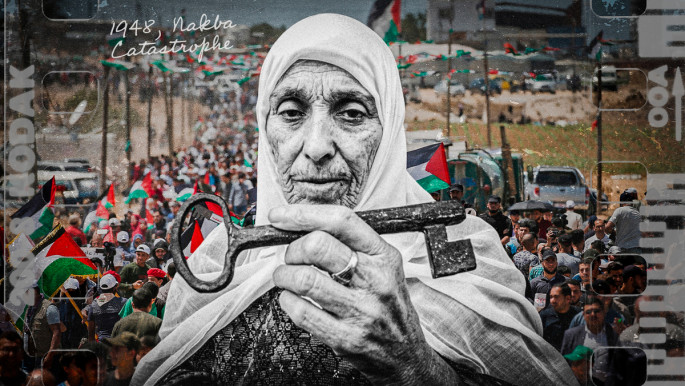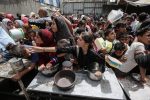At the beginning of February 1947 the British cabinet decided to end the mandate over Palestine and leave the country after nearly 30 years of rule.
The economic crisis in Britain following the Second World War brought a Labor government to power which was willing to shrink the empire and cater for the needs of the people of the British Isles. Palestine proved to be a burden and no longer an asset as both the native Palestinians and the Zionist settlers were now fighting against the British mandate and demanding its end.
The die was cast in a cabinet meeting on 1 February 1947 and the fate of Palestine was entrusted to the UN – an inexperienced international organization back then already affected by the onset of the cold war between the US and the USSR.
Nonetheless the two superpowers consented exceptionally to allow other member states to offer a solution to what was called “the Palestine question” without their interference.
The discussion about Palestine’s future was transferred to the UN Special Committee on Palestine (Unscop) made up of member states. This enraged the Palestinians and member states of the Arab League as they expected post-mandatory Palestine to be treated in the same way any other mandatory state in the region – namely allowing the people themselves to democratically determine their political future.
Nobody in the Arab world would have agreed to allow European settlers in North Africa to take part in determining the future of the newly independent countries. Similarly the Palestinians rejected the idea that the settler Zionist movement – consisting mostly of settlers who had arrived just two years before the UN Palestine refugee agency (UNRWA) was appointed in 1949 – would have a say in the future of their homeland.
The Palestinians boycotted Unscop and as they feared the committee proposed creating a Jewish state on nearly half of their homeland as part of UN General Assembly resolution 181 passed on 29 November 1947.
The Zionist leadership accepted the partition of Palestine (welcoming the principle of a Jewish state) but had no intention of adhering to it in practice seeing as half of the population would still be Palestinian and the space allotted only half of the country coveted by the Zionist movement.
Ethnic cleansing masterplan
Already for more than 30 years historians have unearthed enough declassified archival material mainly from Israel for exposing the Zionist strategy from November 1947 up to the end of 1948. I called the Zionist strategy at the period in my work a masterplan for the ethnic cleansing of Palestine.
The passage of time the exposure of more material and the ever-growing and crucial Palestinian projects of oral history only accentuated the adequacy of applying this term to the events called by the Palestinians the Nakba.
In recent years an old definition of Zionism as a settler colonial movement was revived by scholars researching the history of Palestine. This would clearly explain why the Zionist leadership could never have accepted a partitioned Palestine.
Like any other settler colonial movement it was a movement of Europeans who were outcasts in that continent and had to make a new life for themselves elsewhere usually in places already inhabited by other people.
The need to eliminate indigenous people became the hallmark of such movements leading for instance to the genocide of the Native Americans in North America.
Having as much of the new place with as few natives as possible was already a central theme of the Zionist ideology and movement from its very inception. British rule disabled any significant land takeover (less than six percent of the lands of Palestine were under Zionist ownership by 1948). But on the land that was bought by Zionists mainly through purchase from the Palestinian elite and absentee landowners living outside of Palestine the local farmers were ethnically cleansed with the approval of the British authorities.
The Zionist leadership began planning for the ethnic cleansing of Palestine in February 1947 and early operations took place already a year later under the noses of the British mandatory authorities.
The Zionist leadership needed to rush through its ethnic cleansing operations against the Palestinians in February 1948 starting with the forceful eviction of three villages on the coast between Jaffa and Haifa. The US and other members of the UN had already begun to doubt the wisdom of a partition plan and searched for alternative solutions. The US State Department proposed a five-year international trusteeship over Palestine in order to give additional time for further negotiations.
Facts on the ground
So the first thing the Zionist leadership did was to establish facts on the ground even before the official end of the mandate (due on 15 May 1948). That meant cleansing Palestinians from the areas allocated by the UN for the Jewish state as well as taking over as many of the towns of Palestine as possible.
The Palestinians were no military match for the Zionist paramilitary groups. Some Arab volunteers arrived but could do little to defend the Palestinians from being ethnically cleansed. The Arab world waited until 15 May before sending troops into Palestine.
That the Palestinians were quite defenseless between 29 November 1947 (when the UN partition resolution was adopted) and 15 May 1948 (the day the mandate ended and units from neighboring Arab states arrived to try and save the Palestinians) is not a mere chronological fact. It categorically debunks the main claim in Israeli propaganda about the war – that Palestinians became refugees because the Arab world invaded Palestine and told them to leave; a myth too many people around the world still accept today.
According to this narrative had the Arab world refrained from attacking Israel the Palestinians might have escaped the fate of refugeehood and exile.
Nearly a quarter of a million Palestinians were already refugees before 15 May 1948 and a reluctant Arab world sent its armies to try and save the others.
Almost all Palestinians living in Haifa and Jaffa were forcefully removed from their homes and the towns of Bisan Safad and Acre were completely depopulated. The villages around them suffered a similar fate. In the area around the western slopes of the Jerusalem mountains tens of villages were ethnically cleansed and at times as unfolded in Deir Yassin on 9 April 1948 the expulsions were accompanied by massacres.
Israel’s worst atrocities
The entry of Arab armies – Egypt Syria Jordan and Lebanon – in May 1948 posed a serious challenge to the new state of Israel. But by that time the military capacity of the Jewish community had increased considerably (with the help of weapons from the Eastern bloc that were purchased with Soviet approval from Czechoslovakia which possessed a large number of Second World War surplus arms left behind by the German and Russian armies. (Britain and France embargoed arms supplies to all sides concerned at the time.)
As a result Israeli forces were able to carry out missions on two fronts: first against the Arab armies; and second by continuing its ethnic cleansing operations targeting mostly areas accorded by the UN partition resolution to the Arab state.
The operation in the Upper Galilee in particular recorded some of the worst atrocities committed by the Israeli army during the Nakba: partly because of the fierce resistance of people who already knew the fate awaiting them under Israeli occupation; and partly due to the fatigue of the occupying forces who dispensed with any previous inhibitions in the way they treated the civilian population.
The message from the world to Israel was that the ethnic cleansing of Palestine was acceptable – as compensation for the Holocaust and the centuries of antisemitism in Europe
In the massacre at al-Dawayima near Hebron on 29 October 1948 it is estimated that 455 Palestinians half of them women and children were executed by Israeli soldiers.
Two areas of historical Palestine escaped the fate of being ethnically cleansed. The area that became known as the West Bank was taken over almost without a fight by Jordanian and Iraqi forces. This was in part a tacit agreement between Israel and Jordan that in return for this annexation Jordan would play a minimal military role in the overall Arab effort to salvage Palestine.
Yet under Israeli pressure after the war Jordan conceded during armistice negotiations part of what was supposed to be its West Bank. This area is called Wadi Ara connecting the Mediterranean and the Jenin district.
This annexation posed a problem to a settler colonial state such as Israel. Having more territory meant having also more Palestinians in the Jewish state. Thus smaller ethnic cleansing operations took place to reduce the number of Palestinians living in Wadi Ara.
This connection between geography and demography led Israel’s first prime minister David Ben-Gurion to reject the pressure from his generals to occupy the West Bank (these generals would become the politicians pushing for the takeover of the West Bank in the war of 1967 to compensate for the “mistake” of not occupying it in 1948).
The ongoing Nakba
Israel also left alone another area which became known as the Gaza Strip. It was an artificial rectangle of land Israel created as a huge receptacle for the hundreds of thousands of refugees it cleansed from the southern parts of Palestine and allowed Egypt to keep it as a military-occupied area.
On the ruins of Palestinian villages Israel built settlements (quite often using a Hebrew version of the Arabic name – thus Saffuriya became Tzipori and Lubya became Lavi) or planted parks trying to erase any trace of the culture life and society it destroyed within nine months in 1948.
Half of Palestine’s population became refugees and hundreds of villages were demolished and its towns were de-Arabized by the occupying forces.
The Nakba destroyed a country as well as the lives and aspirations of its people. The huge human capital that Palestinian society had developed was through refugees invested in other Arab countries contributing to their cultural educational and economic development.
The message from the world to Israel was that the ethnic cleansing of Palestine which was well known in the West was acceptable – mainly as compensation for the Holocaust and the centuries of antisemitism that had plagued Europe.
Hence Israel continued its ethnic cleansing after 1967 when once more additional occupied space brought it more “undesired” people. This time the ethnic cleansing was incremental and goes on until today.
Nonetheless the Palestinians are still there showing incredible resilience and resistance – alongside the ongoing Nakba there is an ongoing intifada and as long Israel does not account for what it had done and is doing the colonization will continue as will the anti-colonialist struggle against it.
The only possible way of rectifying past evils is by respecting the right of return of the Palestinian refugees and the establishment of one state all over historical Palestine based on the principles of democracy equality and social justice.
This must be built through a process of restitutive justice which compensates the people for their loss of land careers and life by the new state and with the help of the world.
– Ilan Pappe is a professor of history and director of the European Center for Palestine Studies and co-director for the Exeter Center for Ethno-Political Studies at the University of Exeter. His article appeared in the Middle East Eye.












